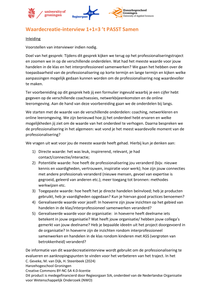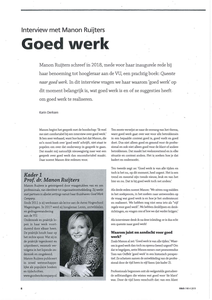Onderzoek naar oefenen met hightech patiëntenpop: gaan studenten zelfverzekerder en beter voorbereid op stage? Vraagbaak Online Onderwijs Stagelopen is voor studenten verpleegkunde vaak spannend en stressvol. Oefenen met een hightech patiëntenpop zorgt voor ruimte om te leren in een realistische omgeving zonder gevaar voor de patiënt. Helpt dit studenten ook om beter voorbereid en met meer zelfvertrouwen aan hun stage te beginnen? Dat onderzoekt Daphne Vogel (Hogeschool Inholland) samen met zorg- en onderwijsinstellingen. Hoe onderzoekt ze dit en wat zijn de eerste indrukken?
LINK
In januari 2019 is het project “Je Ogen Uitkijken” van start gegaan. Dit project wordt uitgevoerd in opdracht van de Vereniging Hogescholen en gefinancierd door de Vereniging Hogescholen en het Ministerie van OCW. Het project “Je Ogen Uitkijken” is een vervolg op Vreemde ogen dwingen (2012) en Zienderogen vooruit (2017), met als doel het versterken van de toetskwaliteit in het hbo. Het doel van het project “Je Ogen Uitkijken” is het ondersteunen en professionaliseren van hogescholen rondom de inrichting van BKE/SKE en het gebruik van Protocol Afstuderen 2.0. Het project kent daarmee twee onderdelen (BKE/SKE en Protocol Afstuderen) die ook weer nauw met elkaar verbonden zijn. Als eerste fase van dit project is een verkenning uitgevoerd onder de hogescholen in Nederland naar de huidige implementatie van Protocol Afstuderen (Beoordelen is Mensenwerk 2.0; Andriessen et al., 2017). In deze beknopte rapportage bespreken we de werkwijze van de verkenning, de resultaten en de implicaties voor het verdere project Je Ogen Uitkijken.
DOCUMENT

De bedoeling van het Protocol Verbeteren en Verantwoorden van Afstuderen in het hbo is om opleidingen in het hbo te helpen samen werken aan het valide, betrouwbaar en voor studenten inzichtelijk toetsen van de beoogde eindkwalificaties, zoals beoogd in standaard 3/16 van de NVAO en het rapport ‘Vreemde ogen dwingen’ van de Commissie Bruijn (Expertgroep Protocol, 2014). Om dit te bereiken heeft het protocol drie doelen: 1. Duidelijkheid scheppen over terminologie en inrichting van het afstuderen. 2. Een kader scheppen voor gezamenlijk leren en verbeteren. 3. Een kader scheppen voor borging en verantwoording.
LINK
Presentatie op congres The Sign Language Proficiency Interview (SLPI) is a tool for assessing functional sign language skill. Based on the Language Aptitude Test, it uses a recorded 20 minute conversation between a skilled interviewer and the candidate. The interview uses an ad hoc series of probing and challenging questions to elicit the candidate’s best use of the sign language in topics relating to the candidate’s work, family/background, and leisure activities. This video language sample is then analyzed to determine the candidate’s rating on the SLPI Rating Scale. The rating process documents vocabulary, grammar and discourse, and follows a specified protocol that includes specific examples from the interview. The SLPI is used widely in the US and Canada with American Sign Language, and one of the presenters has adapted it for use with South African Sign Language. The presenters have recently adapted the SLPI for use with Sign Language of the Netherlands (NGT). While the interview process is the same regardless of the sign language, two aspects of the adaptation for NGT required work: 1) modifying the grammar analysis to match NGT grammar; and 2) modifying the Rating Scale to align with that of the Common European Framework of Reference for languages (CEFR). This ICED presentation will include: 1) a thorough description of SLPI goals, processes and implementation; 2) modifications for NGT grammar; and 3) modifications to align with the CEFR.
DOCUMENT

Interview protocol voor het evalueren van de professionalisering 1+1=3 't PASST Samen
MULTIFILE

Manon Ruijters schreef in 2018, mede voor haar inaugurele rede bij haar benoeming tot hoogleraar aan de VU, een prachtig boek: Queeste naar goed werk. In dit interview vragen we haar waarom 'goed werk' op dit moment belangrijk is, wat goed werk is en of ze suggesties heeft om goed werk te realiseren.
DOCUMENT

ObjectiveIn 2016, a selective preventive spinal immobilization protocol for emergency medical service (EMS) nurses was introduced in the Netherlands. This protocol leaves more room for autonomous decision-making in the pre-hospital phase regarding preventive spinal immobilization (PSI), compared to the previous strict protocol. In this study, we explored the experiences and perspectives of EMS nurses on decisionmaking about PSI after the change from a strict to a selective PSI protocol. Methods: We used a qualitative design with semi-structured face-to-face interviews. Thematic analysis was applied. The capability-opportunity-motivation-behavior-model was used to interpret the experiences and perspectives. Results: Thirteen EMS nurses from three emergency medical services were interviewed. Respondents appreciated autonomous decision-making as there was more room for patient-centered informed decision-making. However, autonomous decision-making required optimized knowledge and skills and elicited the need to receive feedback on their decision not to apply PSI. When nurses anticipated resistance to selective PSI from receiving hospitals, they were doubtful to apply it. Conclusion: Nurses appreciate the increased autonomy in decision-making, encouraging them to focus on patient-centered care. Increased autonomy also places higher demands on knowledge and skills, calling for training and feedback. Anticipated resistance to receiving hospitals based on mutual protocol discrepancies could lead to PSI application by EMS nurses while not deemed necessary. Recommendations: To enhance PSI procedures, optimizing the knowledge and skills of EMS nurses that facilitate on-scene decision-making may be indicated. A learning loop for feedback between the EMS nurses and the involved hospitals may add to their professional performance. More efforts are needed to create support for the changed Emergency Medical Services strategy in PSI to prevent unnecessary PSI and practice variation.
DOCUMENT

Dit wetenschappelijk artikel beschrijft het protocol van de GET READY studie. Deze studie is ontwikkeld voor mensen die een angststoornis of depressie hebben gehad, en dient als terugvalpreventie interventie. De interventie bestaat uit online modules, monitoring en contacten met een POH-GGZ. De achtergrond van terugvalpreventie wordt toegelicht, de methoden van de studie worden gedetailleerd beschreven en er wordt vooruit gekeken naar hoe deze studie een bijdrage kan leveren in het veld van terugvalpreventie.
DOCUMENT

Digitization of activities in hospitals receives more attention, due to Covid-19 related regulations. The use of e-health to support patient care is increasing and efficient ways to implement digitization of processes and other technological equipment are needed. We constructed a protocol for implementation and in this study, we evaluate this protocol based on a case to implement a device in the OR. We used various data sources to evaluate this protocol: semi-structured interviews, questionnaires, and project documents. Based on these findings, this protocol, including identified implementation activities and implementation instructions can be used for implementations of other devices. Implementation activities include setting up a project plan, organizational and technological preparation, maintenance, and training. In future research, these activities and instructions need to be evaluated in more complex projects and a flexible tool needs to be developed to select relevant activities and instructions for implementations of information systems or devices.
LINK
Second career teachers (SCT) are key role models in vocational education (VE) because they prepare students for the vocational practice they were part of, and they bring up-to-date vocational knowledge and skills into VE schools. Therefore, the early leaving of SCTs in VE is a problem, adding to the worldwide teacher shortages. Induction programs have been developed to support starting teachers to grow into their new profession and to diminish high attrition rates. However, it is argued that current induction programs fail to support SCTs adequately. For instance, induction programs rarely adapt to SCTs’ various needs, such as recognizing and integrating previously developed competencies and specific backgrounds. Further-more, SCTs’ induction programs in the specific context of VE are largely under-studied. This study explores the experiences of SCTs in VE during their induction programs regarding four themes identified in research on SCTs in other education sectors: 1) professional identity development, 2) learning processes, 3) tailor-made coaching, and 4) co-creation of induction programs. Eleven SCTs from eight Dutch VE schools were interviewed. The data show a rich variation of SCTs’ experiences. For example, they experienced the opportunity to develop their professional identity as teachers while preserving and including their former identity as practitioners of the vocation they teach for. Yet, only a few SCTs experienced co-creation of the induction program, which seems to have a positive impact. The insights of this study offer an understanding of what SCTs in VE go through and what might support them during their induction.
LINK